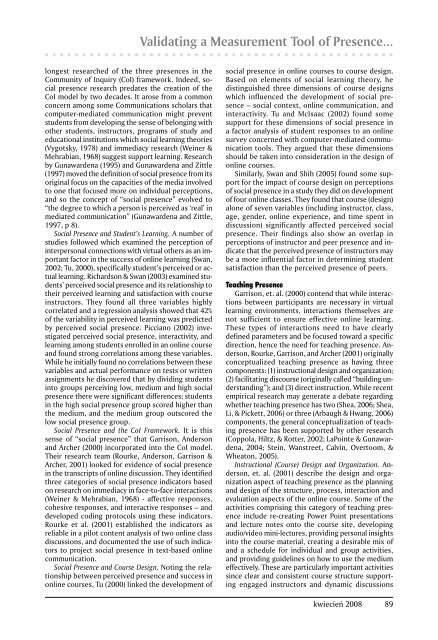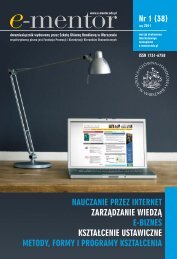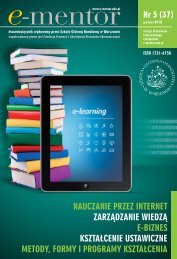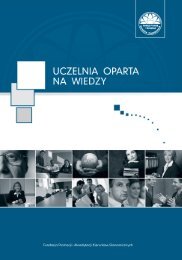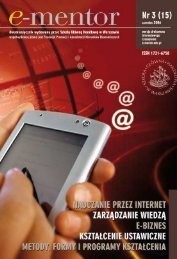Ocena zachowania użytkowników platformy handlu C2C - E-mentor
Ocena zachowania użytkowników platformy handlu C2C - E-mentor
Ocena zachowania użytkowników platformy handlu C2C - E-mentor
Create successful ePaper yourself
Turn your PDF publications into a flip-book with our unique Google optimized e-Paper software.
Validating a Measurement Tool of Presence...longest researched of the three presences in theCommunity of Inquiry (CoI) framework. Indeed, socialpresence research predates the creation of theCoI model by two decades. It arose from a commonconcern among some Communications scholars thatcomputer-mediated communication might preventstudents from developing the sense of belonging withother students, instructors, programs of study andeducational institutions which social learning theories(Vygotsky, 1978) and immediacy research (Weiner &Mehrabian, 1968) suggest support learning. Researchby Gunawardena (1995) and Gunawardena and Zittle(1997) moved the definition of social presence from itsoriginal focus on the capacities of the media involvedto one that focused more on individual perceptions,and so the concept of “social presence” evolved to“the degree to which a person is perceived as ‘real’ inmediated communication” (Gunawardena and Zittle,1997, p 8).Social Presence and Student’s Learning. A number ofstudies followed which examined the perception ofinterpersonal connections with virtual others as an importantfactor in the success of online learning (Swan,2002; Tu, 2000), specifically student’s perceived or actuallearning. Richardson & Swan (2003) examined students’perceived social presence and its relationship totheir perceived learning and satisfaction with courseinstructors. They found all three variables highlycorrelated and a regression analysis showed that 42%of the variability in perceived learning was predictedby perceived social presence. Picciano (2002) investigatedperceived social presence, interactivity, andlearning among students enrolled in an online courseand found strong correlations among these variables.While he initially found no correlations between thesevariables and actual performance on tests or writtenassignments he discovered that by dividing studentsinto groups perceiving low, medium and high socialpresence there were significant differences; studentsin the high social presence group scored higher thanthe medium, and the medium group outscored thelow social presence group.Social Presence and the CoI Framework. It is thissense of “social presence” that Garrison, Andersonand Archer (2000) incorporated into the CoI model.Their research team (Rourke, Anderson, Garrison &Archer, 2001) looked for evidence of social presencein the transcripts of online discussion. They identifiedthree categories of social presence indicators basedon research on immediacy in face-to-face interactions(Weiner & Mehrabian, 1968) - affective responses,cohesive responses, and interactive responses – anddeveloped coding protocols using these indicators.Rourke et al. (2001) established the indicators asreliable in a pilot content analysis of two online classdiscussions, and documented the use of such indicatorsto project social presence in text-based onlinecommunication.Social Presence and Course Design. Noting the relationshipbetween perceived presence and success inonline courses, Tu (2000) linked the development ofsocial presence in online courses to course design.Based on elements of social learning theory, hedistinguished three dimensions of course designswhich influenced the development of social presence– social context, online communication, andinteractivity. Tu and McIsaac (2002) found somesupport for these dimensions of social presence ina factor analysis of student responses to an onlinesurvey concerned with computer-mediated communicationtools. They argued that these dimensionsshould be taken into consideration in the design ofonline courses.Similarly, Swan and Shih (2005) found some supportfor the impact of course design on perceptionsof social presence in a study they did on developmentof four online classes. They found that course (design)alone of seven variables (including instructor, class,age, gender, online experience, and time spent indiscussion) significantly affected perceived socialpresence. Their findings also show an overlap inperceptions of instructor and peer presence and indicatethat the perceived presence of instructors maybe a more influential factor in determining studentsatisfaction than the perceived presence of peers.Teaching PresenceGarrison, et. al. (2000) contend that while interactionsbetween participants are necessary in virtuallearning environments, interactions themselves arenot sufficient to ensure effective online learning.These types of interactions need to have clearlydefined parameters and be focused toward a specificdirection, hence the need for teaching presence. Anderson,Rourke, Garrison, and Archer (2001) originallyconceptualized teaching presence as having threecomponents: (1) instructional design and organization;(2) facilitating discourse (originally called “building understanding”);and (3) direct instruction. While recentempirical research may generate a debate regardingwhether teaching presence has two (Shea, 2006; Shea,Li, & Pickett, 2006) or three (Arbaugh & Hwang, 2006)components, the general conceptualization of teachingpresence has been supported by other research(Coppola, Hiltz, & Rotter, 2002; LaPointe & Gunawardena,2004; Stein, Wanstreet, Calvin, Overtoom, &Wheaton, 2005).Instructional (Course) Design and Organization. Anderson,et. al. (2001) describe the design and organizationaspect of teaching presence as the planningand design of the structure, process, interaction andevaluation aspects of the online course. Some of theactivities comprising this category of teaching presenceinclude re-creating Power Point presentationsand lecture notes onto the course site, developingaudio/video mini-lectures, providing personal insightsinto the course material, creating a desirable mix ofand a schedule for individual and group activities,and providing guidelines on how to use the mediumeffectively. These are particularly important activitiessince clear and consistent course structure supportingengaged instructors and dynamic discussionskwiecień 2008 89


